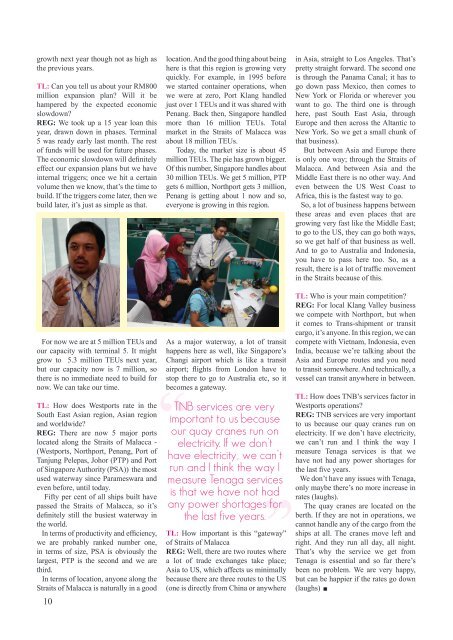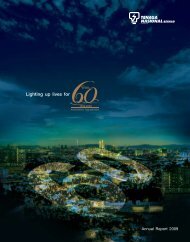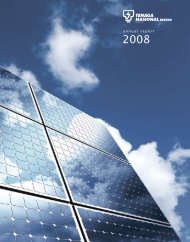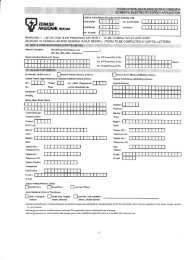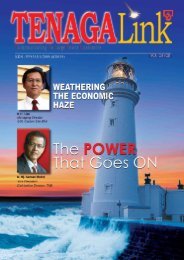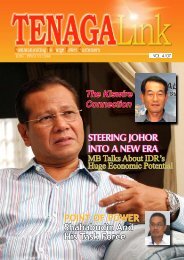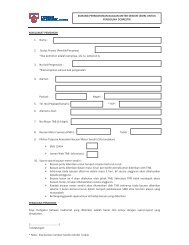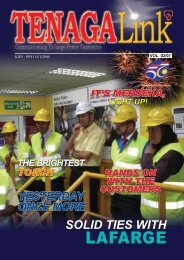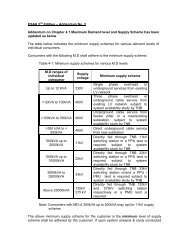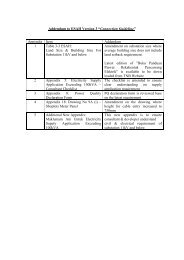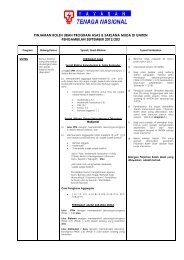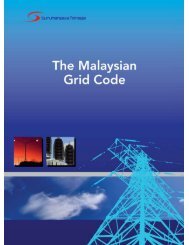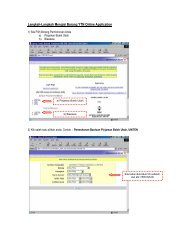S In At - Tenaga Nasional Berhad
S In At - Tenaga Nasional Berhad
S In At - Tenaga Nasional Berhad
You also want an ePaper? Increase the reach of your titles
YUMPU automatically turns print PDFs into web optimized ePapers that Google loves.
growth next year though not as high asthe previous years.TL: Can you tell us about your RM800million expansion plan? Will it behampered by the expected economicslowdown?REG: We took up a 15 year loan thisyear, drawn down in phases. Terminal5 was ready early last month. The restof funds will be used for future phases.The economic slowdown will definitelyeffect our expansion plans but we haveinternal triggers; once we hit a certainvolume then we know, that’s the time tobuild. If the triggers come later, then webuild later, it’s just as simple as that.For now we are at 5 million TEUs andour capacity with terminal 5. It mightgrow to 5.3 million TEUs next year,but our capacity now is 7 million, sothere is no immediate need to build fornow. We can take our time.TL: How does Westports rate in theSouth East Asian region, Asian regionand worldwide?REG: There are now 5 major portslocated along the Straits of Malacca -(Westports, Northport, Penang, Port ofTanjung Pelepas, Johor (PTP) and Portof Singapore Authority (PSA)) the mostused waterway since Parameswara andeven before, until today.Fifty per cent of all ships built havepassed the Straits of Malacca, so it’sdefinitely still the busiest waterway inthe world.<strong>In</strong> terms of productivity and efficiency,we are probably ranked number one,in terms of size, PSA is obviously thelargest, PTP is the second and we arethird.<strong>In</strong> terms of location, anyone along theStraits of Malacca is naturally in a good10location. And the good thing about beinghere is that this region is growing veryquickly. For example, in 1995 beforewe started container operations, whenwe were at zero, Port Klang handledjust over 1 TEUs and it was shared withPenang. Back then, Singapore handledmore than 16 million TEUs. Totalmarket in the Straits of Malacca wasabout 18 million TEUs.Today, the market size is about 45million TEUs. The pie has grown bigger.Of this number, Singapore handles about30 million TEUs. We get 5 million, PTPgets 6 million, Northport gets 3 million,Penang is getting about 1 now and so,everyone is growing in this region.As a major waterway, a lot of transithappens here as well, like Singapore’sChangi airport which is like a transitairport; flights from London have tostop there to go to Australia etc, so itbecomes a gateway.TNB services are veryimportant to us becauseour quay cranes run onelectricity. If we don ’ thave electricity , we can ’ trun and I think the way Imeasure <strong>Tenaga</strong> servicesis that we have not hadany power shortages forthe last five years.TL: How important is this “gateway”of Straits of MalaccaREG: Well, there are two routes wherea lot of trade exchanges take place;Asia to US, which affects us minimallybecause there are three routes to the US(one is directly from China or anywherein Asia, straight to Los Angeles. That’spretty straight forward. The second oneis through the Panama Canal; it has togo down pass Mexico, then comes toNew York or Florida or wherever youwant to go. The third one is throughhere, past South East Asia, throughEurope and then across the Altantic toNew York. So we get a small chunk ofthat business).But between Asia and Europe thereis only one way; through the Straits ofMalacca. And between Asia and theMiddle East there is no other way. Andeven between the US West Coast toAfrica, this is the fastest way to go.So, a lot of business happens betweenthese areas and even places that aregrowing very fast like the Middle East;to go to the US, they can go both ways,so we get half of that business as well.And to go to Australia and <strong>In</strong>donesia,you have to pass here too. So, as aresult, there is a lot of traffic movementin the Straits because of this.TL: Who is your main competition?REG: For local Klang Valley businesswe compete with Northport, but whenit comes to Trans-shipment or transitcargo, it’s anyone. <strong>In</strong> this region, we cancompete with Vietnam, <strong>In</strong>donesia, even<strong>In</strong>dia, because we’re talking about theAsia and Europe routes and you needto transit somewhere. And technically, avessel can transit anywhere in between.TL: How does TNB’s services factor inWestports operations?REG: TNB services are very importantto us because our quay cranes run onelectricity. If we don’t have electricity,we can’t run and I think the way Imeasure <strong>Tenaga</strong> services is that wehave not had any power shortages forthe last five years.We don’t have any issues with <strong>Tenaga</strong>,only maybe there’s no more increase inrates (laughs).The quay cranes are located on theberth. If they are not in operations, wecannot handle any of the cargo from theships at all. The cranes move left andright. And they run all day, all night.That’s why the service we get from<strong>Tenaga</strong> is essential and so far there’sbeen no problem. We are very happy,but can be happier if the rates go down(laughs)


